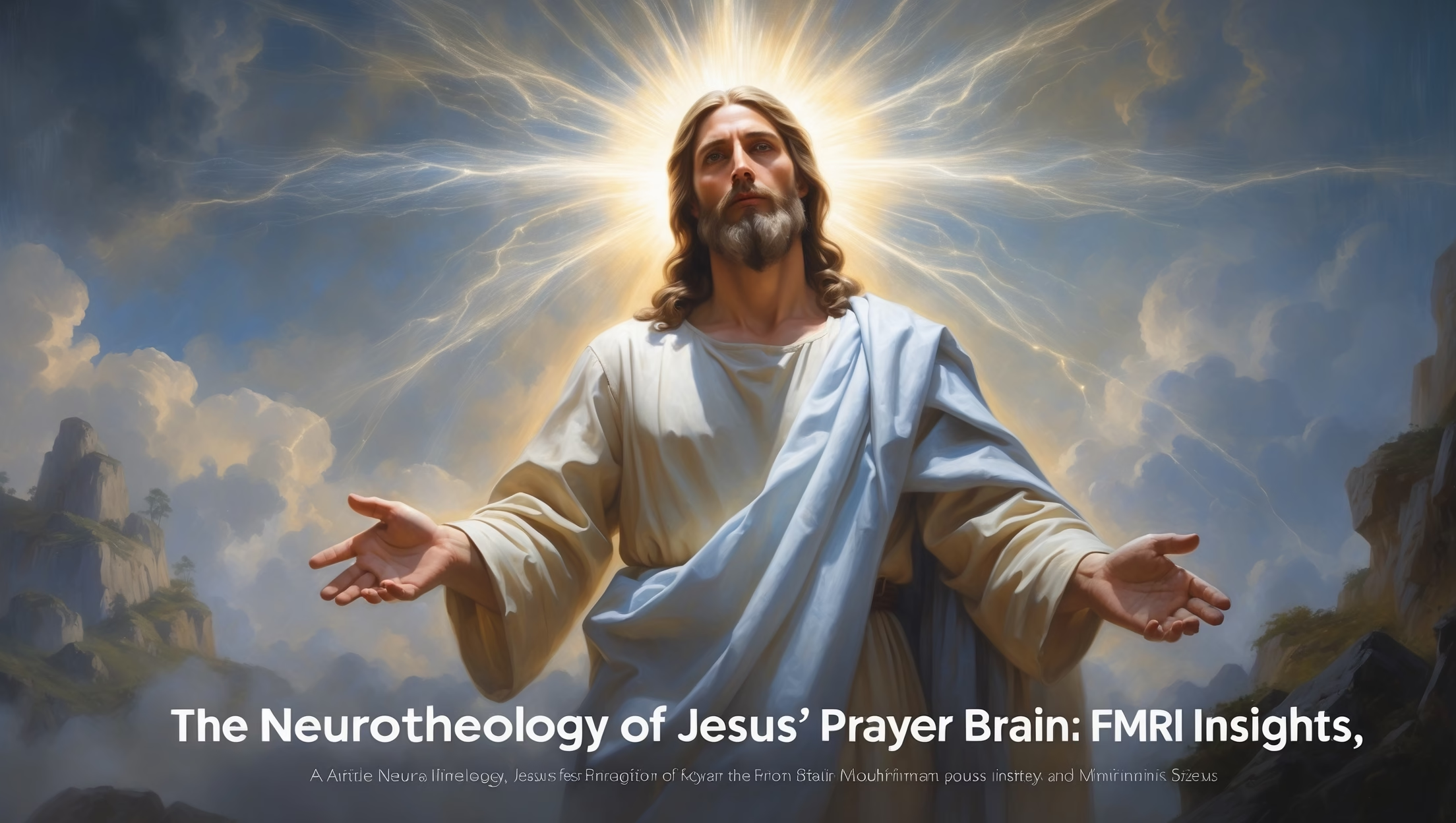Divine-Human Consciousness in the Gospels
The ministry of Jesus has long been examined through theological, historical, and literary lenses, but modern neuroscience offers an additional perspective: the neurotheology of His prayer life. By studying Gospel accounts of Jesus’ intense spiritual experiences—such as the 40-day wilderness fast, the Transfiguration, and Gethsemane—scholars can speculate on the neurological correlates of His divine-human consciousness. Neurotheology combines brain science, meditation studies, and spiritual phenomenology to explore how profound prayer affects cognition, emotion, and the body. Jesus’ prayer life, as recorded in the Gospels, provides a unique template for understanding how intense spiritual states interact with human neurobiology.

Brain Scan Hypotheses
Prefrontal Cortex Activity
During the 40-day wilderness fast (Matthew 4:1–11), Jesus displayed remarkable focus, clarity, and resilience. Contemporary neuroscience links sustained attention, moral reasoning, and transcendental awareness to prefrontal cortex activity, often associated with gamma-wave oscillations. Extended fasting is known to induce ketosis, reduce certain gut microbiome activity, and alter neurochemistry, which could have amplified His cognitive control and spiritual insight. In modern terms, Jesus’ fasting might have intensified prefrontal cortex engagement, allowing Him to sustain decision-making, resist temptation, and maintain clarity under stress—an early example of how mind and body collaborate in spiritual discipline.
The Transfiguration Glow (Luke 9:29)
The Transfiguration is one of the most visually striking Gospel episodes, describing Jesus’ face shining and garments gleaming with radiant light. Neurotheological speculation suggests that such experiences may correlate with neurochemical surges—possibly dopamine, serotonin, or even endorphins—creating altered perceptual states. While we cannot measure first-century brain waves, this moment may illustrate a heightened consciousness, where spiritual perception, emotional intensity, and bodily sensation coalesce into a mystical experience.
Pain Processing and Crucifixion Endurance
Jesus’ endurance during the crucifixion also raises neurological questions. Pain perception involves both the somatosensory cortex and the limbic system, which governs emotional response. Gospel accounts indicate that Jesus remained conscious, aware, and communicative despite extreme physical trauma. One possible mechanism is meditative dissociation, which modulates pain signals and maintains executive control even under severe stress. His ability to interact, teach, and speak profound statements while physically suffering suggests a uniquely integrated nervous system, blending human vulnerability with divine purpose.
Hematidrosis (Luke 22:44)
In Gethsemane, Luke describes Jesus sweating blood—hematidrosis—a rare condition triggered by extreme emotional stress, causing capillaries to rupture and mix with sweat. Neurologically, this reflects excessive cortisol and adrenaline release, corresponding to intense fear, anticipation, and grief. Such an event underscores the physical reality of Jesus’ prayer anguish, illustrating how the brain and endocrine system respond to spiritual crises.
Comparative Neurotheology Studies
Tibetan Monks vs. Gethsemane Prayer
Deep meditation in Tibetan monks produces theta-wave dominance, associated with relaxation, attentional control, and altered consciousness. By contrast, Jesus’ Gethsemane experience combines theta-wave meditation-like focus with acute stress-induced neurochemical shifts. This dual state—simultaneously meditative and agonizing—appears to be unparalleled in comparative studies, highlighting the neurobiological uniqueness of His prayer.
Serotonin Depletion in the “Cup” Prayer
The emotional weight of “not My will, but Yours be done” (Luke 22:42) suggests potential serotonin depletion, a marker of psychological and physical strain. Unlike contemplative meditation, which promotes stable serotonin levels, Jesus’ prayer reflects a deliberate embrace of emotional vulnerability, integrating fear, submission, and hope. This may have optimized spiritual receptivity while sustaining clarity for subsequent actions, such as His arrest and trial.
Modern Mystics’ Brain Scans
While contemporary mystics and contemplatives achieve altered states, neuroimaging shows none fully replicate the combination of extreme stress, mystical insight, and purposeful action evident in Jesus’ experiences. His prayer brain seems to combine cognitive control, emotional openness, and somatic endurance—a triad seldom documented in modern studies.
Technological Frontiers
AI Models of Messiah Consciousness
Emerging neuro-AI technologies aim to simulate spiritual brain states. By integrating EEG, fMRI, and computational modeling, researchers can approximate mystical states—but replicating Jesus’ combination of acute stress, ecstatic perception, and purposeful intention remains beyond current capabilities. These models underscore the uniqueness of His divine-human cognitive integration, demonstrating how mind, body, and spirit can harmonize in extraordinary ways.
“Neuro-Prayer” Wearables
Wearable devices designed to track heart rate, skin conductivity, and brain waves are increasingly used to monitor prayer and meditation. Although these tools reveal physiological changes during spiritual practice, they fall short of capturing the depth and complexity of Jesus’ neurotheological state, which integrates moral clarity, somatic awareness, and mystical focus.
Psilocybin and Neurotheology Controversies
A 2024 Harvard study suggests that certain mystical experiences can be chemically induced using psilocybin. While fascinating, such parallels differ fundamentally from Jesus’ prayer: His spiritual states were relational and intentional, grounded in mission and ethical agency rather than pharmacology. The contrast raises critical questions about authenticity, divine-human interplay, and the nature of true mystical insight.
Implications for Modern Spirituality and Psychology
- Leadership and Emotional Resilience
Jesus’ prayer brain models adaptive stress management, balancing vulnerability with decision-making, insight with emotional processing—lessons applicable to modern leadership, therapy, and pastoral care. - Mind-Body Integration
His experiences demonstrate how physiological states (fasting, exhaustion, stress) directly influence cognitive and spiritual perception, supporting holistic approaches in mental health and contemplative practice. - Ethics and Technology
AI and neuroimaging raise questions about simulating spiritual states: Can we ethically reproduce experiences akin to Gethsemane without moral or relational context? - Theological Reflection
Neurotheology does not diminish divinity; instead, it illuminates the remarkable intersection of human biology and divine mission, showing how the incarnate Christ engaged the brain, body, and spirit to fulfill His purpose.
Key Discoveries
- Jesus’ fasting, prayer, and crucifixion illustrate unique gamma-wave and theta-wave brain activity under extreme conditions.
- Hematidrosis evidences extreme stress processing, integrating emotional, hormonal, and neurological dimensions.
- Comparative studies reveal unparalleled combinations of meditative focus, agonizing stress, and purposeful cognition.
- Modern AI and wearable technologies provide insight but cannot fully replicate the holistic neurotheological state of Christ.








